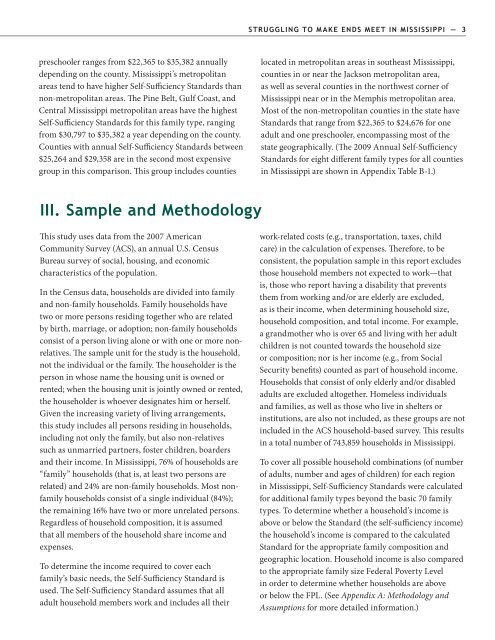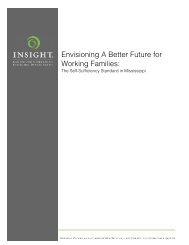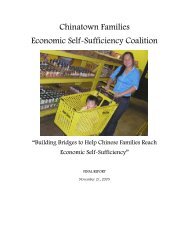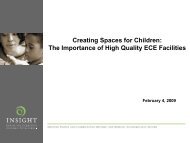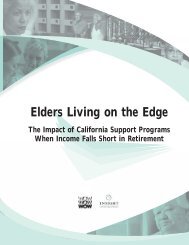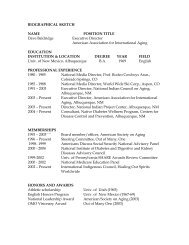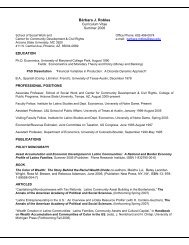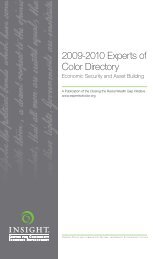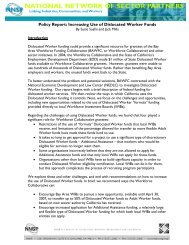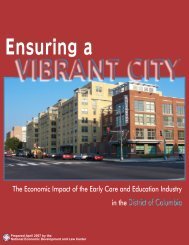Overlooked and Undercounted - Insight Center for Community ...
Overlooked and Undercounted - Insight Center for Community ...
Overlooked and Undercounted - Insight Center for Community ...
You also want an ePaper? Increase the reach of your titles
YUMPU automatically turns print PDFs into web optimized ePapers that Google loves.
STRUGGLING TO MAKE ENDS MEET IN MISSISSIPPI — 3<br />
preschooler ranges from $22,365 to $35,382 annually<br />
depending on the county. Mississippi’s metropolitan<br />
areas tend to have higher Self-Sufficiency St<strong>and</strong>ards than<br />
non-metropolitan areas. The Pine Belt, Gulf Coast, <strong>and</strong><br />
Central Mississippi metropolitan areas have the highest<br />
Self-Sufficiency St<strong>and</strong>ards <strong>for</strong> this family type, ranging<br />
from $30,797 to $35,382 a year depending on the county.<br />
Counties with annual Self-Sufficiency St<strong>and</strong>ards between<br />
$25,264 <strong>and</strong> $29,358 are in the second most expensive<br />
group in this comparison. This group includes counties<br />
located in metropolitan areas in southeast Mississippi,<br />
counties in or near the Jackson metropolitan area,<br />
as well as several counties in the northwest corner of<br />
Mississippi near or in the Memphis metropolitan area.<br />
Most of the non-metropolitan counties in the state have<br />
St<strong>and</strong>ards that range from $22,365 to $24,676 <strong>for</strong> one<br />
adult <strong>and</strong> one preschooler, encompassing most of the<br />
state geographically. (The 2009 Annual Self-Sufficiency<br />
St<strong>and</strong>ards <strong>for</strong> eight different family types <strong>for</strong> all counties<br />
in Mississippi are shown in Appendix Table B-1.)<br />
III. Sample <strong>and</strong> Methodology<br />
This study uses data from the 2007 American<br />
<strong>Community</strong> Survey (ACS), an annual U.S. Census<br />
Bureau survey of social, housing, <strong>and</strong> economic<br />
characteristics of the population.<br />
In the Census data, households are divided into family<br />
<strong>and</strong> non-family households. Family households have<br />
two or more persons residing together who are related<br />
by birth, marriage, or adoption; non-family households<br />
consist of a person living alone or with one or more nonrelatives.<br />
The sample unit <strong>for</strong> the study is the household,<br />
not the individual or the family. The householder is the<br />
person in whose name the housing unit is owned or<br />
rented; when the housing unit is jointly owned or rented,<br />
the householder is whoever designates him or herself.<br />
Given the increasing variety of living arrangements,<br />
this study includes all persons residing in households,<br />
including not only the family, but also non-relatives<br />
such as unmarried partners, foster children, boarders<br />
<strong>and</strong> their income. In Mississippi, 76% of households are<br />
“family” households (that is, at least two persons are<br />
related) <strong>and</strong> 24% are non-family households. Most nonfamily<br />
households consist of a single individual (84%);<br />
the remaining 16% have two or more unrelated persons.<br />
Regardless of household composition, it is assumed<br />
that all members of the household share income <strong>and</strong><br />
expenses.<br />
To determine the income required to cover each<br />
family’s basic needs, the Self-Sufficiency St<strong>and</strong>ard is<br />
used. The Self-Sufficiency St<strong>and</strong>ard assumes that all<br />
adult household members work <strong>and</strong> includes all their<br />
work-related costs (e.g., transportation, taxes, child<br />
care) in the calculation of expenses. There<strong>for</strong>e, to be<br />
consistent, the population sample in this report excludes<br />
those household members not expected to work—that<br />
is, those who report having a disability that prevents<br />
them from working <strong>and</strong>/or are elderly are excluded,<br />
as is their income, when determining household size,<br />
household composition, <strong>and</strong> total income. For example,<br />
a gr<strong>and</strong>mother who is over 65 <strong>and</strong> living with her adult<br />
children is not counted towards the household size<br />
or composition; nor is her income (e.g., from Social<br />
Security benefits) counted as part of household income.<br />
Households that consist of only elderly <strong>and</strong>/or disabled<br />
adults are excluded altogether. Homeless individuals<br />
<strong>and</strong> families, as well as those who live in shelters or<br />
institutions, are also not included, as these groups are not<br />
included in the ACS household-based survey. This results<br />
in a total number of 743,859 households in Mississippi.<br />
To cover all possible household combinations (of number<br />
of adults, number <strong>and</strong> ages of children) <strong>for</strong> each region<br />
in Mississippi, Self-Sufficiency St<strong>and</strong>ards were calculated<br />
<strong>for</strong> additional family types beyond the basic 70 family<br />
types. To determine whether a household’s income is<br />
above or below the St<strong>and</strong>ard (the self-sufficiency income)<br />
the household’s income is compared to the calculated<br />
St<strong>and</strong>ard <strong>for</strong> the appropriate family composition <strong>and</strong><br />
geographic location. Household income is also compared<br />
to the appropriate family size Federal Poverty Level<br />
in order to determine whether households are above<br />
or below the FPL. (See Appendix A: Methodology <strong>and</strong><br />
Assumptions <strong>for</strong> more detailed in<strong>for</strong>mation.)


